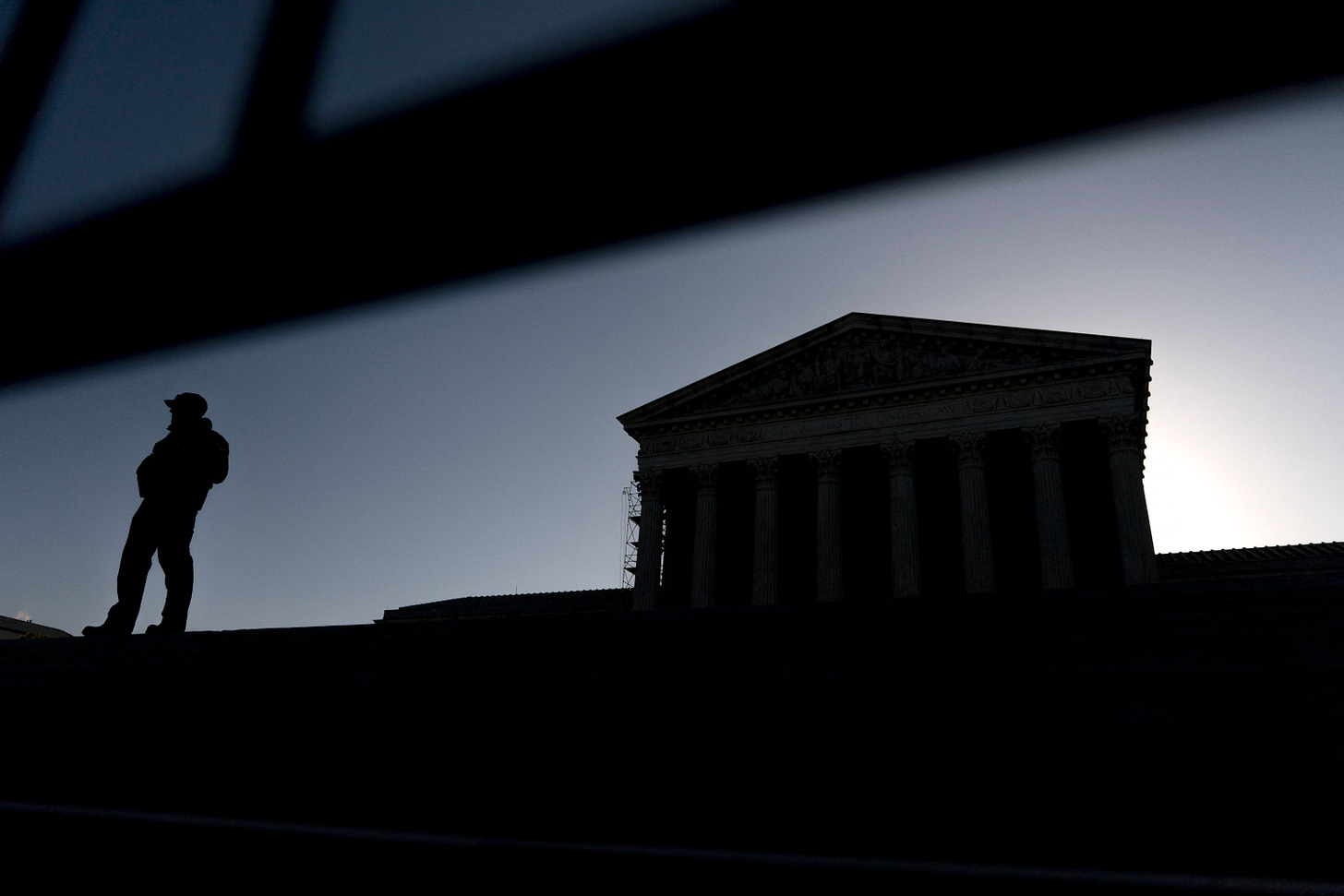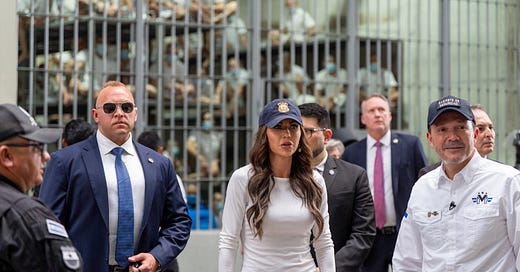
The Alito Flag Story and Other Journalistic Botched Calls
Save your outrage for those who really deserve it.

ONE OF MY FAVORITE PARTS OF THE NEWSEUM was a “what would you do?” exhibit positing various media ethics scenarios and asking visitors what they would do and why. The journalism museum had a prominent spot on Pennsylvania Avenue in the nation’s capital until it ran out of money and shut down in 2019. But the concept has been repurposed as an online instructional tool that helps students “apply journalism standards of accuracy, fairness and clarity in deciding how to report the news.”
The news business is a nonstop series of judgment calls, all day, every day. There are few if any concrete rules, and while some decisions are easy, many only seem that way in hindsight. Which brings us to the Washington Post’s revelation Saturday that a reporter and his editor knew about the upside-down American flag at Justice Samuel Alito’s house more than three years ago, and—drumroll—did not write a story.
The outrage over the Post’s decision may be in the rearview mirror even as you read this, superseded by a cascade of further outrages: A second controversial flag, this one at the Alito beach house in New Jersey, linked like the first one to efforts to overturn Joe Biden’s 2020 win; Alito’s refusal Wednesday to recuse himself from cases related to the January 6th attack on the U.S. Capitol where both flags were seen; and Donald Trump—awaiting a jury verdict in his first criminal trial—thanking Alito for having “the INTELLIGENCE, COURAGE, and ‘GUTS’ to refuse stepping aside from making a decision on anything January 6th related.”
Even before all this, I couldn’t get too worked up about the Post’s decision not to pursue the Alito story back in 2021. That’s probably because I did not know until a couple of weeks ago—when an editor added a phrase to one of my own articles, complete with links to photos—that the upside-down U.S. flag had become a “Stop the Steal” symbol, and that rioters flew them at the Capitol on January 6th.
And it’s not for lack of paying attention. Like many journalists and political obsessives, I have closely tracked the Capitol attack, its aftermath, and its flags. I knew, and wrote two years ago, that the Confederate flag had been inside the Capitol that day for the first time ever. I knew that the mob carried Trump flags, and three years ago quoted a judge lecturing a January 6th defendant about his misplaced allegiance to Trump instead of the United States.
Even without knowing the details, it’s indisputable that in late January 2021, Martha-Ann Alito’s conflicts with her neighbors would have been a solid Metro or Style section feature, as George Conway noted last week. And in fact, the Supreme Court reporter who saw the flag and asked Mrs. Alito about it discussed that possibility at the time with his then-editor, Cameron Barr. But an article never happened. “In retrospect, I should have pushed harder for that story,” Barr told Semafor on Sunday.
Such an article, so soon after similar upside-down flags had been part of the Capitol riot, would have provoked heated debate about the propriety and ethics of a justice allowing this incendiary symbol to fly for days over his lawn. Many of us might have understood a lot more, a lot sooner, about this Court and the MAGA movement. The Post might have learned back then that Justice Alito’s explanation for why his wife put up the inverted flag—in response to a vulgar insult from neighbors—does not match the timeline of events, as the Times reported Tuesday: In fact, it had already been hoisted when the heated exchanges occurred. Still, before hammering the Post, consider the context of the conversation about the Alitos’ flag back in January 2021. It was long before the House January 6th Committee held hearings and collected evidence that showed Justice Clarence Thomas’s wife, Ginni Thomas, had texted White House chief of staff Mark Meadows about trying to overturn an election she called “the greatest Heist of our History” and asked twenty-nine Arizona state legislators to fight fraud by choosing a “clean” slate of electors to replace Biden’s electors. (The fraud claims were false and eighteen people have been indicted in connection with Arizona’s “fake electors” scheme.)
It was also long before ProPublica exposed the many massive gifts Justice Thomas received from wealthy conservatives with interests before the Court. And long before the June 2022 Dobbs decision, in which the conservative supermajority engineered by Trump, Mitch McConnell, and powerful outside interests threw out the court’s 1973 ruling that legal abortion was a constitutional right.
“The Post’s move was cautious and deferential, and very pre-Dobbs. Now, it’s hard to imagine,” Semafor’s Ben Smith wrote. He’s right, and one hopes this is a teachable moment—for Congress and for reporters.
EVERY JOURNALIST HAS REGRETS and makes wrong calls. One of mine is the faith I placed in then-Secretary of State Colin Powell—my “deferential” attitude toward him—when he told the United Nations that Iraqi President Saddam Hussein had a stockpile of chemical weapons and we couldn’t just wait for him to use it. I could not imagine Powell making that argument unless he believed it—and like so many others, I trusted that if he believed it, the intelligence had to be solid.
Another wrong call of mine, from the same period, was my skepticism toward Howard Dean, the physician and longtime Vermont governor who was running for the 2004 Democratic presidential nomination as a full-on opponent of the Iraq invasion and the notion of preemptive war. I remember asking him once why he thought he knew better than the many candidates and political leaders far more familiar with warfare, world affairs, and weapons of mass destruction. He replied with typical self-assurance that he trusted his advisers.
Dean was a relatively isolated voice in the aftermath of the 9/11 attacks. Amid lingering public fears, President George W. Bush and many others built support for the war based on two premises—that Saddam had WMDs, as Powell laid out at the U.N., and that Saddam had ties to terrorists, including what Bush called “high-level contacts” with those who attacked America on 9/11. Both premises were widely believed at the time, Pew Research Center polls show, but neither was true.
The Iraq war dragged on for more than eight years and diverted resources and focus from what turned into a twenty-year war in Afghanistan. By 2019, most of the public, including most veterans, had decided the Iraq war had not been worth fighting.
THERE ARE SO MANY WAYS TO GET IT WRONG, and there are also so many people who overestimate the power of the press. I covered John Kerry’s 2004 campaign for USA Today, and in December 2004, at a panel discussion on coverage of the race, I had a mini-meltdown about the Swift Boat Veterans for Truth episode.
In brief: Vietnam veterans trashed the Democratic nominee’s war record and contended he had lied about it, but fact checks discredited the attacks and a Kerry response ad featured other men praising his leadership. “He risked his life to save mine,” Jim Rassmann said of Kerry, who pulled him out of a river while they were under fire. And a line from Swift Boat veteran Del Sandusky that I remember to this day: “The decisions that he made saved our lives.”
I pointed out at the time that the “mainstream media” got this one right, but it didn’t matter. “Almost immediately my paper and other papers started debunking these charges and raised questions about the people who were making them,” I said shortly after the 2004 election. “The Times, USA Today, the Washington Post, the Chicago Tribune, nobody had an impact on this. We were nothing in the day of cable television and talk radio.”1
You notice what I didn’t mention: Fox News, not yet the juggernaut it is now, and the internet, still in its formative stages as a weapon of mass disinformation. And maybe “we were nothing” was a bit overwrought. The “legacy media” still publishes stories that set the agenda for everyone. The Times reports on the Alito family flags are a good example.
Still, using accountability as the measure, it’s easy to argue that little has changed. What has Congress done since the Ginni Thomas, Clarence Thomas, and Samuel Alito ethics problems have come to light? Since the news last year that Chief Justice John Roberts’s wife, Jane, had earned $10 million in commissions from placing lawyers at top firms, some of which had business before the Court? Where are the investigations, the hearings, the new laws? Where are the lawmakers insisting on a stronger ethics code, one with recusal requirements and enforcement mechanisms?
Alito’s impunity will be a model going forward unless outrage somehow morphs into action—and guaranteed consequences for failure to meet the most obvious, fundamental moral and ethical standards required of a Supreme Court justice.
If you need more proof of the impotence of media critiques of misleading or deceptive campaign tactics, check out the career arc of the man Politico dubbed the “Swift Boat mastermind”: Chris LaCivita went on to run a Trump super PAC in 2020 and now is both a senior campaign adviser to Trump and chief of staff at the Trump owned-and-operated Republican National Committee.
















